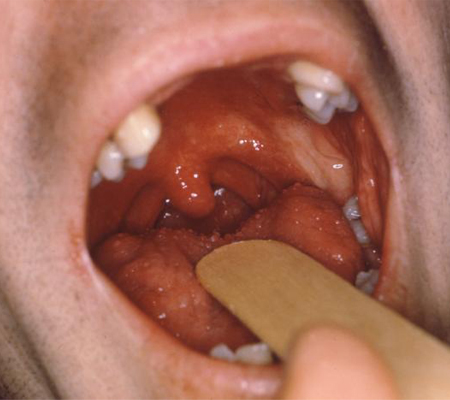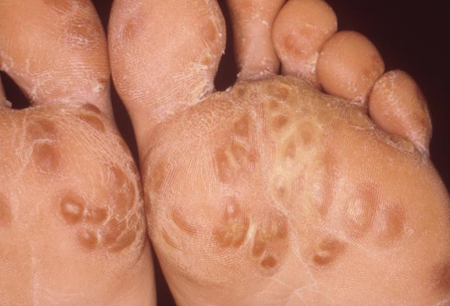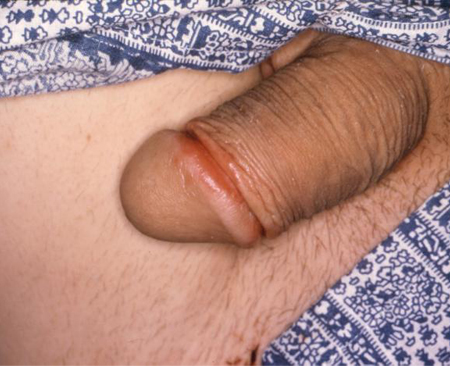History and exam
Key diagnostic factors
common
peripheral arthritis
Clinical symptoms typically begin within 1 to 4 weeks after the onset of infection. The latency in developing arthritis associated with postchlamydial infections may be longer than that associated with postdysenteric infections.[66]
The arthritis is most commonly an asymmetric oligoarthritis. However, polyarticular and monoarticular arthritis can occur.
There is usually a predilection for the larger joints in the lower extremity. The inflammation often leads to painful, swollen, warm, red, and stiff joints, especially in the morning. Swelling of entire digits (fingers or toes), termed dactylitis, is a specific finding within the spondyloarthropathies arising from flexor tenosynovitis. Usually, patients are defined as having chronic ReA when joint symptoms have been present for more than 6 months.
axial arthritis
Spinal inflammation, especially of the sacroiliac joints and lumbosacral spine, is a common finding.
Symptoms manifest as nonspecific low back pain and/or buttock pain and stiffness, especially during times of inactivity. Symptoms are generally relieved by exercise, which distinguishes spinal inflammatory arthritis from mechanical causes of back pain.
Thoracic and cervical spine involvement occurs with chronic ReA.
Other diagnostic factors
common
constitutional symptoms
Fever, fatigue, and weight loss are common.
enthesitis
This is inflammation at sites where tendons insert into bones. Common sites include the Achilles' tendon and plantar fascia at the calcaneus, which manifest as heel pain.
uncommon
mucous membrane involvement
Patients may develop superficial painless oral ulcers along with urethritis and sterile dysuria.Inflammation of the bladder and prostate can lead to cystitis and prostatitis.[Figure caption and citation for the preceding image starts]: Mucosal ulcers in a patient with reactive arthritis.Image provided by the CDC Public Health Image Library [Citation ends].
skin rash
Keratoderma blennorrhagicum is a skin disorder characterized by hyperkeratotic skin in about 12% of patients.
It appears as a vesicular lesion that becomes plaquelike or pustular and is microscopically indistinguishable from pustular psoriasis. These lesions most often occur on the soles or palms, but have been described elsewhere.[Figure caption and citation for the preceding image starts]: Keratoderma blenorrhagia in a patient with reactive arthritis.Image provided by the CDC Public Health Image Library [Citation ends].
circinate balanitis
Painless ulcers and plaque-like lesions on the shaft or glans of the penis.[Figure caption and citation for the preceding image starts]: Balanitis in a patient with reactive arthritis.Image provided by the CDC Public Health Image Library [Citation ends].
ocular manifestations
Ocular inflammation in the form of conjunctivitis can cause redness, tearing, and a sterile purulent discharge during the acute period.
Anterior uveitis (iritis), associated with HLA-B27 positivity, causes symptoms of pain, redness, and photophobia. Iritis often becomes chronic.
cardiac manifestations
Inflammation of the aorta can lead to aortitis, which can cause aortic regurgitation, precipitating heart failure. Arrhythmias occur secondary to scarring of the conduction system by chronic inflammation.
Risk factors
strong
male sex
There is a 9:1 male to female incidence ratio of Chlamydia-induced ReA. The male to female incidence ratio of postdysentery ReA is approximately 1:1.[51]
HLA-B27 genotype
preceding chlamydial or gastrointestinal infection
ReA occurs after exposure to certain gastrointestinal and genitourinary infections, particularly Chlamydia species, Campylobacter jejuni, Salmonella enteritidis, Shigella, and Yersinia.
Use of this content is subject to our disclaimer